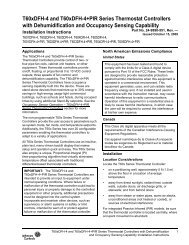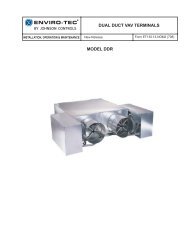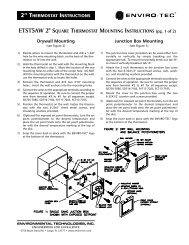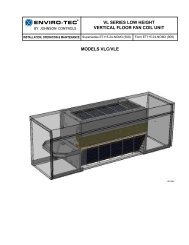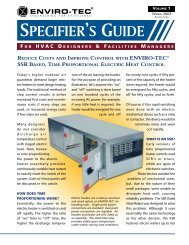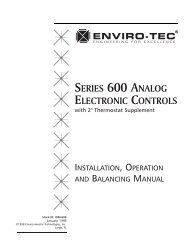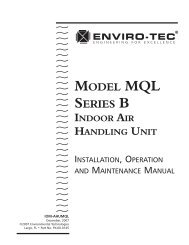VF Series C Vertical Floor Fan Coil Unit - Enviro-Tec
VF Series C Vertical Floor Fan Coil Unit - Enviro-Tec
VF Series C Vertical Floor Fan Coil Unit - Enviro-Tec
- No tags were found...
You also want an ePaper? Increase the reach of your titles
YUMPU automatically turns print PDFs into web optimized ePapers that Google loves.
FORM ET115.24-NOM10 (1210)• Verify fan speed will change from High, Medium,and Low by utilizing remote 3 speed switch,thermostat or connecting by P18 to P15, P18 toP16, or P18 to P17. If fan speeds are adjustablethe relay board is producing 24 Volts.• If board is not working, measure 24 volts betweenP20 and P19, if 24 volts (19-29 VAC) is not presentthen measure across terminals S1 and R, if24 volts (19-29 VAC) is not present then returnboard to local sales representative.JP3• Verify plug jumper JP3 (Figure 5) is installed orwire (Figure 6) is installed between W2 and R.Either JP3 or wire jumper must alwaysbe installed unless thermostat drawingindicates otherwise.JP3 should be removed for singlespeed operation using "G" terminal.For thermostat with 3 speed switching,remove JP1 but leave JP3 installed.FIG. 5 - FAN COIL RELAY BOARD (CURRENT)S1 – Common side of transformer. Jumped to “C” (common)through JP2. If application calls for float switch JP2 isremoved and float switch is connected between S1 and C.S2 – Convenience terminal. Not connected to other componentson the board. Used for different functions based onapplication, such as 2nd stage heat control tie point for twostage EH applications, or changeover water valve/aquastattie point for two pipe changeover applications. May also beused as tie point for “Close” input of modulating hot watervalve actuator and “Close” output of thermostat in floating[tristate] water valve applications.R – Transformer “hot” connection (side of transformer that’snot the one used for valve actuator, EH, etc. commons). Controloutputs to board should close to “R” to energize (Referto thermostat literature. At least one thermostat, the JohnsonControls T600/TEC model line is known to use the “R” forvalve common but the “C” for fan speed common. This isthe only known (by JCI Largo Engineering) case in whichthis occurs. All other thermostats dealt with use the “C” forall device commons).C – Device common, including onboard speed relays (allterminals “C” and “COM” on board are tied together).C – Device commonY1 – Tie point for chilled water valve actuator control input,and thermostat cooling output. Convenience terminal, notconnected to anything else on board.W1 – Tie point for hot water valve actuator or 1st stage EHcontrol input, and thermostat heating output. Convenienceterminal, tied to P22 “Heat” quick connect for factory terminationto EH relay if applicable.Y2 – tie point for “Close” input of modulating chilled watervalve actuator or 2nd stage chilled water valve actuatorcontrol input, and thermostat cooling output. Convenienceterminal, not connected to anything else on board. Y1 is“Open” output if floating {tristate} chilled water valve actuatoris supplied (or used).G – Connected to “R” thru JP3. Used (with JP3 removed) forinput from single speed (residential style) thermostats that donot supply three speed fan switching. In these applications, aseparate three speed switch may be used with the “H”, “M” or“L” inputs, of the provided jumper to set a fixed fan speed. Ifthermostat supports three speed switching, “H”, “M” and “L”inputs should be used, and JP3 should remain in place.H – High speed control input for onboard relay. Parallels theP17 “HIGH” quick connect input. If thermostat or independentthree speed switch is used, remove jumper JP1 (femaleto female quick jumper wire).M – Medium speed control for onboard relay. Parallels theP16 “MED” quick connect input.L – Low speed control input for onboard relay. Parallels theP15 “LOW” quick connect input.HEAT (P22) – Same functionality as W1 when operatingEH.28ENVIRO-TEC ®




